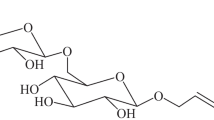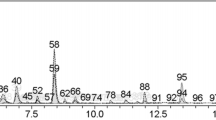Abstract
Purpose
The flavanone isoxanthohumol (IX) has gained attention as antioxidative and chemopreventive agent, but the molecular mechanism of action remains unclear. We investigated effects of this secondary plant compound in vivo using the model organism Caenorhabditis elegans.
Methods
Adult C. elegans nematodes were incubated with IX, and then, the stress resistance was analysed in the SYTOX assay; lifespan was monitored by touch-provoked movement method, the amount of reactive oxygen species (ROS) was measured in the DCF assay, and the nuclear localisation of the transcription factor DAF-16 was analysed by using a transgenic strain. By the use of a DAF-16 loss-of-function strain, we analysed whether the effects are dependent on DAF-16.
Results
IX increases the resistance of the nematode against thermal stress. Additionally, a reduction in ROS in vivo was caused by IX. Since the flavanone only has a marginal radical-scavenging capacity (TEAC assay), we suggest that IX mediates its antioxidative effects indirectly via activation of DAF-16 (homologue to mammalian FOXO proteins). The nuclear translocation of this transcription factor is increased by IX. In the DAF-16-mutated strain, the IX-mediated increase in stress resistance was completely abolished; furthermore, an increased formation of ROS and a reduced lifespan was mediated by IX.
Conclusion
IX or a bacterial metabolite of IX causes antioxidative effects as well as an increased stress resistance in C. elegans via activation of DAF-16. The homologous pathway may have implications in the molecular mechanism of IX in mammals.




Similar content being viewed by others
References
Stevens JF, Page JE (2004) Xanthohumol and related prenylflavonoids from hops and beer: to your good health! Phytochemistry 65:1317–1330
Gerhäuser C (2005) Beer constituents as potential cancer chemopreventive agents. Eur J Cancer 41:1941–1954
Possemiers S, Bolca S, Grootaert C, Heyerick A, Decroos K, Dhooge W, De Keukeleire D, Rabot S, Verstraete W, Van de Wiele T (2006) The prenylflavonoid isoxanthohumol from hops (Humulus lupulus L.) is activated into the potent phytoestrogen 8-prenylnaringenin in vitro and in the human intestine. J Nutr 136:1862–1867
Krause E, Yuan Y, Hajirahimkhan A, Dong H, Dietz BM, Nikolic D, Pauli GF, Bolton JL, van Breemen RB (2014) Biological and chemical standardization of a hop (Humulus lupulus) botanical dietary supplement. Biomed Chromatogr 28:729–734
Monteiro R, Faria A, Azevedo I, Calhau CJ (2007) Modulation of breast cancer cell survival by aromatase inhibiting hop (Humulus lupulus L.) flavonoids. Steroid Biochem Mol Biol 105:124–130
Izzo G, Söder O, Svechnikov K (2011) The prenylflavonoid phytoestrogens 8-prenylnaringenin and isoxanthohumol differentially suppress steroidogenesis in rat Leydig cells in ontogenesis. J Appl Toxicol 31:589–594
Bolca S, Li J, Nikolic D, Roche N, Blondeel P, Possemiers S, De Keukeleire D, Bracke M, Heyerick A, van Breemen RB, Depypere H (2010) Disposition of hop prenylflavonoids in human breast tissue. Mol Nutr Food Res 54(Suppl 2):284–294
Negrão R, Duarte D, Costa R, Soares R (2013) Isoxanthohumol modulates angiogenesis and inflammation via vascular endothelial growth factor receptor, tumor necrosis factor alpha and nuclear factor kappa B pathways. BioFactors 39:608–622
Serwe A, Rudolph K, Anke T, Erkel G (2012) Inhibition of TGF-β signaling, vasculogenic mimicry and proinflammatory gene expression by isoxanthohumol. Invest New Drugs 30:898–915
Tronina T, Bartmańska A, Filip-Psurska B, Wietrzyk J, Popłoński J, Huszcza E (2013) Fungal metabolites of xanthohumol with potent antiproliferative activity on human cancer cell lines in vitro. Bioorg Med Chem 21:2001–2006
Delmulle L, Bellahcène A, Dhooge W, Comhaire F, Roelens F, Huvaere K, Heyerick A, Castronovo V, De Keukeleire D (2006) Anti-proliferative properties of prenylated flavonoids from hops (Humulus lupulus L.) in human prostate cancer cell lines. Phytomedicine 13:732–734
Allsopp P, Possemiers S, Campbell D, Gill C, Rowland I (2013) A comparison of the anticancer properties of isoxanthohumol and 8-prenylnaringenin using in vitro models of colon cancer. BioFactors 39:441–477
Potaniec B, Grabarczyk M, Stompor M, Szumny A, Zieliński P, Żołnierczyk AK, Anioł M (2014) Antioxidant activity and spectroscopic data of isoxanthohomol oxime and related compounds. Spectrochim Acta A Mol Biomol Spectrosc 118:716–723
Yang JY, Della-Fera MA, Rayalam S, Baile CA (2007) Effect of xanthohumol and isoxanthohumol on 3T3-L1 cell apoptosis and adipogenesis. Apoptosis 12:1953–1963
Philips N, Bynum D, Hwang H (2014) Counteraction of skin inflammation and aging or cancer by polyphenols and flavonoids from Polypodium leucotomos and xanthohumol. AntiInflamm Antiallergy Agents Med Chem 9:142–149
Brenner S (1974) The genetics of Caenorhabditis elegans. Genetics 77:71–94
Gill MS, Olsen A, Sampayo JN, Lithgow GJ (2003) An automated high-throughput assay for survival of the nematode Caenorhabditis elegans. Free Radic Biol Med 35:558–565
Büchter C, Ackermann D, Havermann S, Honnen S, Chovolou Y, Fritz G, Kampkötter A, Wätjen W (2013) Myricetin-mediated lifespan extension in Caenorhabditis elegans is modulated by DAF-16. Int J Mol Sci 14:11895–11914
Mukhopadhyay A, Oh SW, Tissenbaum HA (2006) Worming pathways to and from DAF-16/FOXO. Exp Gerontol 41:928–934
Piersen CE (2003) Phytoestrogens in botanical dietary supplements: implications for cancer. Integr Cancer Ther 2:120–138
Chadwick LR, Pauli GF, Farnsworth NR (2006) The pharmacognosy of Humulus lupulus L. (hops) with an emphasis on estrogenic properties. Phytomedicine 13:119–131
Koch K, Havermann S, Büchter C, Wätjen W (2014) Caenorhabditis elegans as model system in pharmacology and toxicology: effects of flavonoids on redox-sensitive signalling pathways and ageing. Sci World J. doi:10.1155/2014/920398
Kampkötter A, Gombitang Nkwonkam C, Zurawski RF, Timpel C, Chovolou Y, Wätjen W, Kahl R (2007) Effects of the flavonoids kaempferol and fisetin on thermotolerance, oxidative stress and FoxO transcription factor DAF-16 in the model organism Caenorhabditis elegans. Arch Toxicol 81:849–858
Grünz G, Haas K, Soukup S, Klingenspor M, Kulling SE, Daniel H, Spanier B (2012) Structural features and bioavailability of four flavonoids and their implications for lifespan-extending and antioxidant actions in C. elegans. Mech Aging Dev 133:1–10
Kampkötter A, Nkwonkam CG, Zurawski RF, Timpel C, Chovolou Y, Wätjen W, Kahl R (2007) Investigations of protective effects of the flavonoids quercetin and rutin on stress resistance in the model organism Caenorhabditis elegans. Toxicology 234:113–123
Kampkötter A, Timpel C, Zurawski RF, Ruhl S, Chovolou Y, Proksch P, Wätjen W (2008) Increase of stress resistance and lifespan of Caenorhabditis elegans by quercetin. Comp Biochem Physiol B: Biochem Mol Biol 149:314–323
Zarse K, Jabin S, Ristow M (2012) l-Theanine extends lifespan of adult Caenorhabditis elegans. Eur J Nutr 51:765–768
Yanase S, Yasuda K, Ishii N (2002) Adaptive responses to oxidative damage in three mutants of Caenorhabditis elegans (age-1, mev-1 and daf-16) that affect life span. Mech Ageing Dev 123:1579–1587
Abbas S, Wink M (2010) Epigallocatechin gallate inhibits beta amyloid oligomerization in Caenorhabditis elegans and affects the daf-2/insulin-like signaling pathway. Phytomedicine 17:902–909
Kawasaki I, Jeong MH, Oh BK, Shim YH (2010) Apigenin inhibits larval growth of Caenorhabditis elegans through DAF-16 activation. FEBS Lett 584:3587–3591
Lin K, Dorman JB, Rodan A, Kenyon C (1997) daf-16: an HNF-3/forkhead family member that can function to double the life-span of Caenorhabditis elegans. Science 278:1319–1322
Cai WJ, Huang JH, Zhang SQ, Wu B, Kapahi P, Zhang XM, Shen ZY (2011) Icariin and its derivative icariside II extend healthspan via insulin/IGF-1 pathway in C. elegans. PLoS One 6:e28835
Havermann S, Chovolou Y, Humpf HU, Wätjen W (2014) Caffeic acid phenethylester increases stress resistance and enhances lifespan in Caenorhabditis elegans by modulation of the insulin-like DAF-16 signalling pathway. PLoS One 9(6):e100256
Ristow M, Schmeisser S (2011) Extending life span by increasing oxidative stress. Free Radic Biol Med 51:327–336
Miller RA (2009) Cell stress and aging: new emphasis on multiplex resistance mechanisms. J Gerontol A Biol Sci Med Sci 64:179–182
Sykiotis GP, Habeos IG, Samuelson AV, Bohmann D (2011) The role of the antioxidant and longevity-promoting Nrf2 pathway in metabolic regulation. Curr Opin Clin Nutr Metab Care 14:41–48
Possemiers S, Heyerick A, Robbens V, De Keukeleire D, Verstraete W (2005) Activation of proestrogens from hops (Humulus lupulus L.) by intestinal microbiota; conversion of isoxanthohumol into 8-prenylnaringenin. J Agric Food Chem 53:6281–6288
Acknowledgments
We thank Dr. Sebastian Honnen (Heinrich-Heine-University, Düsseldorf) for critical comments. The nematode strains used in this work were provided by the Caenorhabditis Genetics Centre, which is funded by the NIH National Centre for Research Resources (NCRR). We thank Dr. Gerd Hause (Biozentrum, Halle) and Prof. Dr. Bettina Hause (IPB, Halle) for being able to use the fluorescence microscope.
Conflict of interest
The authors declare that there is no conflict of interests regarding the publication of this manuscript.
Author information
Authors and Affiliations
Corresponding author
Electronic supplementary material
Below is the link to the electronic supplementary material.
Rights and permissions
About this article
Cite this article
Büchter, C., Havermann, S., Koch, K. et al. Isoxanthohumol, a constituent of hop (Humulus lupulus L.), increases stress resistance in Caenorhabditis elegans dependent on the transcription factor DAF-16. Eur J Nutr 55, 257–265 (2016). https://doi.org/10.1007/s00394-015-0843-z
Received:
Accepted:
Published:
Issue Date:
DOI: https://doi.org/10.1007/s00394-015-0843-z




